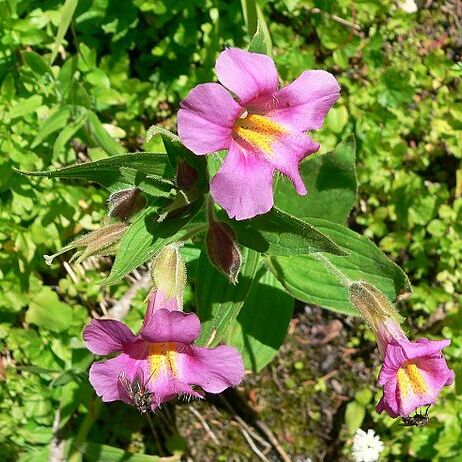Fls axillary, ± pilose to glab., solitary or occ. racemed. Calyx sub-campanulate, 5-angled, 5-lobed. Corolla with long tube terminating in 2-lipped limb; upper lip 2-lobed, erect to patent; lower 3-lobed, throat us. with 2 protuberances. Stamens 4, didynamous, anther-cells divergent, often confluent at apex. Style slender, stigma 2-lamellate. Capsule 2-valved, loculicidally dehiscent. Herbs with opp. simple, entire or toothed lvs. Some 120 spp. of America, Asia, Africa, Australia, Tasmania, N.Z. The N.Z. sp. also in Tasmania.
Cal tubular, angled or prismatic, the lobes usually shorter than the tube; cor bilabiate, the lower lip arched in the throat, or with 2 elevated ridges partly or wholly closing the orifice; stamens 4, inserted near the middle of the cor-tube; pollen-sacs divergent; style elongate; stigmas 2, plate-like; fr cylindric, loculicidal; ours perennial herbs with rhizomes or stolons; lvs opposite; fls showy, yellow to red or blue, on solitary axillary pedicels. 120, widespread but mainly w. N. Amer.
Corolla bilabiate, tubular; tube cylindric to slightly dilated at mouth, villous within, longer than lips; posterior lip bilobed, exterior in bud; anterior lip trilobed usually with two proturberances in throat; lobes subequal, rounded.
Stamens 4, didynamous, included or exserted; filaments filiform, variously inserted near base of corolla-tube; anthers bithecal, cells distinct or confluent at apex.
Calyx 5-toothed, generally 5-ribbed or 5-angled, lobes shorter than tube, somewhat unequal, ovate-acuminate, tube campanulate.
Capsule cylindric to ovoid, loculicidally dehiscent Seeds numerous, small, ellipsoid.
Ovary bilocular, oblong with many ovules; style filiform with usually bilobed stigma.
Inflorescence of terminal, leafy racemes or flowers solitary, axillary.
Herbs, erect or decumbent, glabrous, pilose or viscid.
Leaves opposite, simple, entire or dentate.

